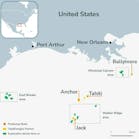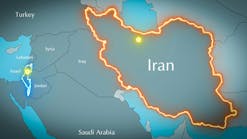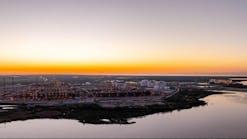TransCanada PipeLines Ltd., Calgary, has almost doubled its North American gas transmission volumes since 1989 and is seeking new markets to conquer.
Mainline capacity is running at 6.36.4 bcfd, compared with less than 3.9 bcfd in 1989.
The company continues to expand its main Canadian system but plans international expansion. It is following a game plan involving investments in several pipeline projects in the U.S. while targeting business opportunities in South America and Asia.
TransCanada operates 8,451 miles of mainline system in Canada with 56 compressor stations. The line, with loops, stretches from the Alberta-Saskatchewan border across Canada to Quebec province and links western gas to markets in eastern Canada and the U,S. Exports totaled 43% of all deliveries in 1993.
Last year the system, which connects with four Canadian and nine U.S. pipelines, shipped a record 2.128 bcf, compared with 1.418 bcf in 1989. Deliveries last year included 1.205 bcf to Canadian markets and 923 bcf to export markets. Total deliveries were up 7.9% in 1993 from 1992, and export volumes increased 10.4% year to year.
The company, through its wholly owned Western Gas Marketing Ltd., is one of the largest gas marketers in North America.
Western sold 1.179 bcf in 1993, down a little from 1992's volume of 1.191 bcf due to increased competition in spot sales. Canadian sales of 600 bcf totaled 51% of business, while export sales to U.S. buyers of 579 bcf accounted for the rest.
Western has a supply pool of 730 gas producers under 2,345 contracts. The company renegotiated contract with major buyers in 1993 to provide indexed pricing and computerized it trading operations.
SYSTEM EXPANSIONS
TransCanada has undertaken a massive expansion program during the past 5 years to meet shipper needs and burgeoning demand for natural gas in Canada and the U.S. The company, with assets of more than $8 billion Canadian, has invested $4.6 billion since 1989 on system expansion to cash in on growing demand.
Gerald J. Maier, chairman and chief executive officer, says the company anticipated substantial changes and increasing North American demand in 1986. Plans were made then to prepare for shipper needs and the responsibility of moving increased volumes to customers in Canada and the U.S.
"The realization of the game plan has unfolded much as we conceived it, although not in all details or in precise timing," he said.
"We had to ensure that finances and capital structure of the company were very strong so we could borrow money and complete capital projects that would be involved. Construction and heavy outlay of capital didn't start until 1989 and will continue until 1995. I expect a capital program of $450-470 million this year."
Maier says the fundamental factor in expansion is demand for pipeline capacity from shippers.
"We build to meet requirements and in response to requests from shippers for shipping space. That's what drives our business", Maier said.
"As you can understand, it would be totally inconceivable to continue with the incredible growth pace we've had since 1989. That's a rapid pace in anybody's mind. It can't go on forever."
Maier says the 1994 capital program is still significant in North American terms and more modest only in comparison with spending in recent years.
Mainline capital expenditures were $661 million in 1989 when the program began, $470 million in 1990, $1.380 billion in 1991, $1.310 billion in 1992, and $741 million in 1993.
The ambitious expansion program has vaulted TransCanada into the top ranks of North American gas deliverers. The company reckons it ranks second in deliveries with 9.99% of the market, compared with 11.4% held by Transco and 9.73% by third place Northern Natural Gas Co. TransCanada says it has moved up to its present place from the number five ranking it held in 1990.
Maier says the expansion program appears disjointed because of the need to file applications with the National Energy Board and obtain approval in pieces. But it is part of a cohesive development program.
On the supply side, there are a number of estimates of remaining gas reserves in western Canada. Figures used by TransCanada are based on a study by Sproule & Associates, Calgary engineering firm, updated each year.
"That figure puts the ultimate potential of the western Canada basin at about 340 tcf--something of that order," Maier said. "I don't think it's a bad number, but no one really knows."
He points out that the figure does not take into account longer term supply potential of areas such as the Mackenzie Delta in the Arctic, where there are large but currently uneconomic, gas discoveries.
PART INTERESTS
Company growth is based on rapid mainline expansion and a web of shared interests and connections with TransCanada and other pipelines in Canada and the U.S. TransCanada's Canadian pipeline interests include a:
- 50% interest in the Trans Quebec & Maritimes Pipeline with partner Gaz Metropolitain Inc., Montreal. The 201 mile line from Montreal to Quebec City, with capacity of 500 MMcfd extends the TransCanada network across the continent from western Canada into Quebec in the east.
- 44% interest in Foothills Pipe Lines (Sask.) Ltd. Other interest holders are Foothills Pipe Lines Ltd. 51% and Consolidated Pipe Lines Co. 5%. The 161 mile line from Empress, Alta., to Monchy, Sask., is operated by TransCanada with a capacity of 1.48 bcfd. The line, which moves gas to the Northern Border pipeline system and markets in the U.S. Midwest, shipped 485 bcf in 1993, up 10% from the previous year.
- 49.9% interest in Alberta Natural Gas Co. Ltd.'s line from Coleman, Alta., to a border delivery point at Kingsgate, B.C. The 110 mile line, with capacity of 2.497 bcfd, delivers western Canada gas to a connection with the Pacific Gas Transmission (PGT) line serving markets in the U.S. Northwest and California. Volumes on the ANG line totaled 519 bcf in 1993, up 5% from the previous year. TransCanada holds an option to buy the PGT line from parent Pacific Gas & Electric Co., San Francisco. TransCanada expects to act on that option this year.
The company's U.S pipeline interests include a:
- Long standing 50% interest in the Great Lakes Gas Transmission System with partner Coastal Great Lakes Inc. The 1,985 mile line from Emerson, Man., to Sarnia, Ont., has capacity of 2.1 bcfd and shipped 854 bcf in 1993 to markets in the eastern U.S. and Canada. A $100 million (U.S.) outlay in 1993 boosted capacity by 158 MMcfd.
- 30% interest in Northern Border Pipeline Co. with 70% partner Northern Border Intermediate LP. The 969 mile line, rated at 1.675 bcfd, runs from Monchy to Harper, Iowa. In 1993 it delivered 579 bcf to markets in the U.S. Midwest and elsewhere, up 12% from 1992 volumes.
- 29% interest in the 12 partner Iroquois Gas Transmission System. Other major partners are Tenneco Gas 13.2%, Brooklyn Union Gas Co. 11.4%, and Yankee Energy Systems Inc. 10.5%. The 376 mile line, running from Iroquois, Ont., to Long Island, N.Y., carried 236 bcf in 1993 to markets in New York, New England, and New Jersey. That was an increase of 49% from 1992. The system is operated by Iroquois Pipeline Operating Co., a wholly owned unit of TransCanada. Iroquois installed its first compressor station in 1993 and is seeking regulatory approval for a second compressor unit and metering facilities. Maier calls TransCanada's investment in Iroquois system and its rapid expansion key factors in growth of the Canadian mainline, which remains the core of TransCanada operations, and the expanded Great Lakes system.
PROPOSED LINES
TransCanada has made a number of investments in other pipeline systems in the U.S., which it sees as important elements for its North American growth.
Maier sees potential for continued growth of Canadian gas exports to the primary U.S. market, but there is no guarantee all of the additional volumes will be shipped on the TransCanada system. He say's the company aims for steady growth and has no intention of putting all its eggs in one basket.
TransCanada interests in proposed lines in the regulatory mill include the Tuscarora pipeline in Nevada, Mayflower line in New England, and SunShine pipeline system in Florida. Timing of the projects depends on market demand and the regulatory process.
TransCanada is a 50% partner in the proposed $125 million (U.S.) Tuscarora pipeline with Sierra Pacific Resources. Tuscarora's proposal, under an application filed with the Federal Energy Regulatory Commission in 1993, calls for a 229 mile line from the PGT system to serve markets in northern Nevada and Northeast California. The partners hope for regulatory approval in 1995 and a construction start shortly thereafter.
TransCanada holds a 30% interest in the proposed $650 million SunShine pipeline project in Florida. Other partners are Florida Power Corp. 30% and Coastal Corp. 40%. The 685 mile line is to have two sections. SunShine Interstate Transmission Co. (Sitco) would extend from Mississippi through Alabama into Florida. SunShine Pipeline Co. would receive gas from Sitco and cross Florida to a terminal near Tampa. Sitco has received construction approval from the Florida Public Service Commission, subject to an environmental review.
TransCanada decided 2 years ago that international pipeline operations an d power cogeneration projects would be essential elements in the company's growth.
COGENERATION PROJECTS
TransCanada has a number of cogeneration projects in place or planned in Canada and the U.S. but says not all potential projects fit its needs for investment.
It has two power projects in place.
The wholly owned Nipigon Power Plant at Nipigon, Ont., producing 36,000 kw of power, is fueled by western Canada gas and waste heat from an adjacent mainline power station.
TransCanada has a 40% interest in the Ocean State power plant in Rhode Island, which began operation in 1990. It produced more than 500,000 kw in 1993 using 100 MMcfd of Canadian natural gas.
The company also is at work on plans to locate power generation plants in the North Bay and Kapuskasing, Ont., using waste heat from mainline compressors. Ontario Hydro, the client utility, scaled back the size of the plants to 40,000 kw from an initial 150,000 kw. TransCanada says subject to regulatory approvals, construction of the plants could begin in 1995 with a start-up date at the end of 1996.
TransCanada also owns a one third interest in the proposed 460,000 kw Hermiston Power Project, a proposed cogeneration plant near Hermiston, Ore. The plant has been named as one of three energy options for the area by the federal power authority. If selected, the first phase of the $375 million U.S. venture would begin construction between 1995 and 2,000. The 227,000 kw unit would use 87 MMcfd of gas delivered by PGT.
INTERNATIONAL PROGRAM
Maier says the capacity of TransCanada and companies like it to develop gas transmission and power projects exceeds opportunities in the North American market. The company is building on its experience in these areas for international business development.
It lost out in bidding on one of its first international ventures for a piece of the action with partners in Argentina's Del Norte pipeline system. Since then, it has been laying the groundwork for ventures in several other countries and has bid on a number of projects. Maier says local partners are essential for offshore ventures.
In 1993, TransCanada researched market opportunities in Argentina, Chile, and Mexico and bid on proposed pipeline projects in Colombia and Viet Nam.
The company is close to signing a business alliance with a major firm in Mexico, where it sees strong potential for opportunities. It did not get a contract on the Colombia project but is continuing talks with Colombian authorities on other projects. There has been no decision to date on the Vietnamese project.
TransCanada and partner Ocelot Energy Inc. were successful with an initial bid for a $200 million (U.S.) project in Tanzania. A 137 mile pipeline would connect an offshore gas field with a 100,000 kw power plant in Dar es Salaam.
The Canadian firms, notified in January that their initial bid was accepted, are proceeding with exclusive second round negotiations. The project is to go into service in 1996, subject to negotiations and acceptable financing arrangements.
GAS STORAGE
TransCanada also has diversified its operations into a new area with several investments in gas storage.
Last October, the company announced a 40% equity participation in the $120 million (U.S.) Washington 10 underground storage project in Southeast Michigan. Its partners are MCN Corp. 40%, Panhandle Eastern Pipeline Co. 10%, and Union Gas Ltd. 10%. The facility, with 42 bcf of storage capacity, is subject to regulatory approvals and market demand.
TransCanada also acquired an option to earn a significant interest in the East Crossfield natural gas storage site in Alberta to be operated by Amoco Canada Petroleum Ltd.
East Crossfield is to have at least 20 bcf of storage capacity at first, with potential to increase to 80 bcf. The project began in February with completion of a horizontal well.
Copyright 1994 Oil & Gas Journal. All Rights Reserved.


